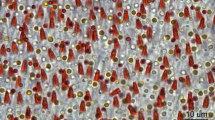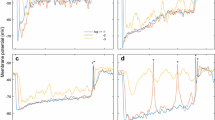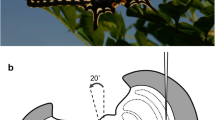Summary
The nine receptor cells examined in each ommatidium of the butterfly Papilio aegeus aegeus can be named according to their positional orientation across the fused rhabdom. Six of them end as short visual fibres (svf) in the second stratum of the lamina, whereas the remaining three retinula cells (lvf) pass together with the lamina fibres (L-fibres) the first optic ganglion and the outer chiasma to end in the three most distal layers of the second optic ganglion, the medulla. The organization of the retinula-cell axons within the pseudocartridge and the cartridge remains almost uniform throughout the first optic ganglion. Five L-fibres, which have their origin in the fenestrated layer (FL), join each laminar cartridge before entering the neuropil of the first optic region. Four of these L-fibres (L-1, L-2, L-3 and L-4) could be definitely located and characterized using Golgi-stained light- and electron-microscopic techniques. Whereas L-1 and L-3 show a lateral branching pattern reaching only fibres of the same cartridge, L-2 and L-4 have long collaterals interconnecting several neighbouring cartridges in a characteristic pattern. Serial sections of silver-impregnated retinula-cell axons as well as L-fibres were investigated for their synaptic connectivity patterns between and within these fibres. These cellular interactions and possible information processing are discussed.
Similar content being viewed by others
References
Bernard GD (1979) Red-absorbing visual pigment of butterflies. Science 203:1125–1127
Boschek CB (1971) Retina and lamina ganglionaris of the fly, Musca domestica. Z Zellforsch 118:369–409
Chi C, Carlson DS (1976) High voltage electron microscopy of the neuropile of the housefly, Musca domestica. Cell Tissue Res 167:537–545
Crane J (1955) Imaginal behaviour of a Trinidad butterfly with special reference to the social use of colour. Zoologica NY 40:167–196
Gordon WC (1985) Nonconventional interaction between photoreceptor axons in the butterfly lamina ganglionaris. Z Naturforsch 40c:460–463
Horridge GA, Marcelja L, Jahnke R, Matic T (1983) Single electrode studies on the retina of the butterfly Papilio. J Comp Physiol A 150:271–294
Horridge GA, Marcelja L, Jahnke R (1984) Colour vision in butterflies. I. Single colour experiments. J Comp Physiol A 155:529–542
Kaiser W (1974) The spectral sensitivity of the honey bee's optomotor walking response. J Comp Physiol A 90:405–408
Kolb G (1977) The structure of the eye of Pieris brassicae L. (Lepidoptera). Zoomorphology 87:123–146
Kolb G (1978) Zur Rhabdomstruktur des Auges von Pieris brassicae L. (Insecta, Lepidoptera). Zoomorphology 91:191–200
Laughlin SB, Hardie RC (1978) Common strategies of light adaptation in the peripheral visual system of the fly and dragonfly. J Comp Physiol A 128:319–340
Matic T (1983) Electrical inhibition in the retina of the butterfly Papilio. I Four spectral types of photoreceptors. J Comp Physiol A 152:169–182
Meinertzhagen IA (1976) The organization of perpendicular fibre pathways in the insect optic lobe. Phil Trans R Soc Lond [Biol] 274:555–596
Meinertzhagen IA, Menzel R, Kahle G (1983) The identification of spectral receptor types in the retina and lamina of the dragonfly Sympetrum rubicundulum. J Comp Physiol 151:295–310
Menzel R (1974) Spectral sensitivity of monopolar cells in the bee lamina. J Comp Physiol 93:337–346
Menzel R (1979) Spectral sensitivity and colour vision in invertebrates. In: Autrum H (ed) Comparative physiology and evolution of vision in invertebrates. Handbook of sensory physiology, vol VII/6A Springer, Berlin Heidelberg New York, pp 503–580
Menzel R, Blakers M (1976) Colour receptors in the bee eye-morphology and spectral sensitivity. J Comp Physiol 108:11–33
Ribi WA (1978a) Ultrastructure and migration of screening pigments in the retina of Pieris rapae L. (Lepidoptera, Pieridae). Cell Tissue Res 191:57–73
Ribi WA (1978b) A unique hymenopteran compound eye. The retina fine structure of the digger wasp Sphex cognatus Smith: (Hymenoptera, Sphecidae). Zool Jb Anat 100:299–342
Ribi WA (1978c) Colour receptors in the eye of the digger wasp Sphex cognatus Smith: Evaluation by selective adaptation. Cell Tissue Res 195:471–483
Ribi WA (1978d) Gap junctions coupling photo-receptor axons in the first optic ganglion of the fly. Cell Tissue Res 195:299–308
Ribi WA (1981) The first optic ganglion of the bee. IV. Synaptic fine structure and connectivity patterns of receptor cell axons and first order interneurones. Cell Tissue Res 215:443–464
Ribi WA (1983) Combined Golgi and electron microscopy techniques. In: Miller TA (ed) Experimental entomology, Vol II: Neuroanatomical techniques. Springer, Berlin Heidelberg New York, pp 1–18
Ribi WA (1984) The first optic ganglion of the bee. V. Structural and functional characterization of centrifugally arranged interneurones. Cell Tissue Res 236:236–584
Shaw SR (1969) Interreceptor coupling in ommatidia of drone honey bee and locust compound eyes. Vision Res 9:999–1029
Shaw SR (1981) Anatomy and physiology of identified non-spiking cells in the photoreceptor-lamina complex of the compound eye of insects, especially Diptera. In: Roberts A, Bush BMH (eds) Neurons without impulses: their significance for vertebrate and invertebrate nervous systems. Cambridge University Press, Cambridge London New York New Rochelle Melbourne Sydney, pp 61–116
Strausfeld NJ (1971) Organization of the insect visual system. I Projections and arrangement of neurons in the lamina ganglionaris of Diptera. Z Zellforsch 121:377–441
Strausfeld NJ, Blest AD (1970) Golgi studies on insects Part I. The optical lobes of Lepidoptera. Phil Trans R Soc Lond 258:81–134
Author information
Authors and Affiliations
Rights and permissions
About this article
Cite this article
Ribi, W.A. Anatomical identification of spectral receptor types in the retina and lamina of the Australian orchard butterfly, Papilio aegeus aegeus D.. Cell Tissue Res. 247, 393–407 (1987). https://doi.org/10.1007/BF00218321
Accepted:
Issue Date:
DOI: https://doi.org/10.1007/BF00218321




